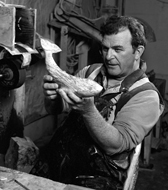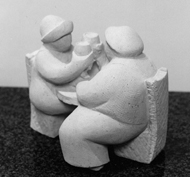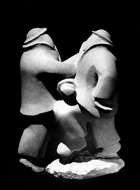When they sent me a list of questions to prompt my submitting material for an article about myself, the first question was: Who are you? I’ve never thought bio’s to be of enduring interest to anyone but the person they describe—so I’ve contrived shortest sketch possible to show how I fit in our stone sculpture world:
I’m a country boy from the boondocks of northern Ontario, a place that looked really good in the rear-view mirror as I hied off to join the navy at 17. In 1970, now 31, married, kids, salesman, a serendipitous meeting with Toronto sculptor E.B. Cox resulted in an instant obsession for pursuing the life of a sculptor in stone. In a month, I had my own hammer and chisel and was making chips fly under E.B.’s tutelage. Five years and five sellout ‘home’ shows later, still enraptured, I panicked my wife by quitting a high paying day job in sales to move to Vancouver, the only place in Canada where you can sculpt outdoors year ‘round. I was certain I could make a living as a sculptor. It was not because I was your world’s great artist (I never did get to be so) but I had three compensatory attributes: I was never satisfied with the last sculpture I had created; I had an innate understanding of tools; most importantly, I could sell.
By 1983, a series of successful ‘home’ shows resulted in a stable of George Pratt collectors beginning to form; the phone was ringing somewhat regularly and while income was never assured, it was becoming adequate. When a strapping gal named Meg Pettibone trekked up to Vancouver to seek help in forming a guild of sculptors in stone, I bought in to the notion and along with a small group of other sculptural aspirants, we established the NWSSA. Twenty-five years onward, I have had uncounted successful shows, been commissioned to produce presentation sculptures for many world leaders, and have authored seven major public artworks.
I’ve carved (or tried to) every type of stone, emerging in my senior years as primarily a granite carver. I still like to work and produce but my ego has had all the stroking it needs. I still think of myself as being only a moderately good artist who gets it right now and again. I put what I can back into the profession that has been so very good to me by instructing others. (Instruction has its own payback; every year at our symposia, I am afforded the profound pleasure of meeting aspiring sculptors whose talent far outstrips mine. Dang, if only they could sell.)
And that about sums me up. Now, to the important stuff. In a thirty-nine-year career I’ve touched upon countless others in the stone arts. I’ve listened and watched and made every experience a lesson. Here are a few vignettes that for me have been formative.
Wisdom From My Old Mentor: E.B. Cox
This advice from my irascible, curmudgeonly and talented mentor still sticks with me.
Nowadays they go out of their way to make art that is—well—odd. It seems not to be so possessed of artistic merit as just—oddness. Don’t be fooled by it, boy. Don’t do odd.
A stone sculpture should reflect the attributes of stone: Think mass; think strength. Stone is not the stuff of thin birds’ wings and angels’ fingers. It is the stuff of bears and whales; it is the stuff of torsos—males with brawny shoulders, females with strong hips.
If you want to carve alluring females boy, stop messing about with playboy breasts; look to the neck and shoulders, boy; look to lusty hips. Those breasts you’ve hammered out are for truck-drivers.
Don’t be seduced into carving every colored stone you see; colored stones, shiny finishes, they’re cute but they lack the most important feature of sculpture: shadow and mood. Go for the plain stones, boy. What’s locked up in colored stones is glitz; what’s locked up in limestone and granite and white marble is elegance.
Encounters That Influenced My Career
Meeting Meg Pettibone in 1984. It was she who conceived of the notion of a guild of sculptors in stone that became the NWSSA and who inveigled me into helping get it started.
Meeting Rich Beyer at the first meeting. It was from him I learned that sculpture could be light-hearted and rustic and that the best sculptures tell a story. (Take a look at Rich’s vignette in Fremont, ‘Waiting for the Interurban’. It’s located at Fremont Ave. N and N 34th St.) When Rich’s principles as a Quaker would not allow him to sculpt a portrayal of Eskimos bearing weapons for the Alaska Veterans Memorial, he recommended me for the job; thus I acquired my first major sculpture in granite.
Working in the same space as other creative people, in particular stone sculptors (hence, the value of attending as many symposia as one can), I’ve shared workspace with E.B. Cox, Michael Binkley, Dave Fushtey and Sandra Bilawich (the latter three being early NWSSA members.) I do not copy them, but I have been abundantly inspired by them and influenced by them in a way that I would not be if they were but casual sculptor acquaintances. It is by day in-day out being close enough to watch the way they apply their skill, to observe their thought processes in working through thorny technical problems, to be delighted (or otherwise) by a line or form developing in their current project and subliminally emulating it in one’s own work. Invaluable.

Influences/landmark Events/philosophies That Have Been Formative To Me
Work Hard And Often
Contrary to what one may think, when we unceasingly create sculpture, we don’t get hackneyed Ideas and skills flow exponentially with the rate of production. In working ourselves to exhaustion, we just get better.
‘Coffee-table’ Sculptures
I develped the method for producing ‘coffee-table’ sculptures outside the Eskimo soapstone realm by working hard stones on a stationary grinder. Such sculptures were just not done by anybody when I discovered the silicon carbide grinding wheel and carbide cloth disc in 1971. It was by being able to produce, in relatively short time, neat little sculptures in stones other than soapstone, which apparently charmed people and could be sold for an affordable price, that I was able to make a living.
The tools for grinding have evolved from those primitive carbide wheels to specially formulated diamond discs (and much more) now, but the grind/cut/polish method remains the same. Above all else, this phenomenon of producing the ‘coffee-table sculpture’ will provide the ability to carry on as a sculptor, for it assures one’s solvency while struggling to attract commissions for greater works that will inevitably follow.
High, Gleaming Polish On Jade
When trying to unlock the secretsof polishing jade, the process defeated me, I resignedly walked the ten blocks to the studio of jade sculptor Lyle Sopel, who at the time, was struggling in his sculptural niche as was I in mine, and humbly asked him to show me how. I am grateful that this he very patiently did.
I haven’t done a lot of jade sculptures over the years but those I’ve done have all found great favor and whatever excellence may be in them is the result of that fortuitous hour of instruction from Lyle.
(See his website: www.sopel.com)
Attending Symposia
There is nothing, absolutely nothing, so valuable to a stone sculptor as to be immersed in an environment of others of like mind, all making the chips fly. I cannot place a value on the experience of being exposed to the works of others as they were being carved, works that I wish I had done: Tracy Powell’s ‘Little Man With a Horn’; Tamara Buchanan’s ‘Man In a Coat’; Dorbe Holden’s ‘Female Figure’; the basalts of Rich Hestekind; the finishing textures of Stuart Jacobsen; the contextual excellence of in the wonderful (and difficult) sculpture John Hoge (remember him?) did for the Polytechnical Institute. These and a couple of dozen more (sorry if I didn’t name you) have made deposits into my mental bank account that have paid uncounted interest over the years. Every sculpture I have carved has been partially financed by making a withdrawal from the account; yet the principal does not deplete because each year as I attend a symposium, the account is replenished.
Finding Deep Pockets
I discovered the importance of ingratiating myself to persons in the interior design and corporate community in building a source of sales. It is this group of people who can recommend our work to the people among us with the deepest pockets. Related people of influence, but no less important, have been the individuals whose responsibility is to acquire corporate gifts. Building a reputation among this group has generated uncountable sales of ‘corporate presentation sculptures’ over the years - and the recipients of such gifts have in turn very often made contact and begun acquiring presentation gifts for their own purposes. It has been a very rich source of sales.
My Photos
I have literally hundreds of images of works large and small, traditional and contemporary, importantly commissioned and tossed off casually. I purposely chose the pictures shown for two reasons: They reflect what E.B. Cox advised me about plain stones and shadow and mood; and I thought it might be interesting to show works that an old NWSSA member did years before many of those who will attend the 2009 Symposium were born. In the same spirit, I know these feature articles like to show a picture of the sculptor. I picked over the many I have, both complimentary and otherwise, and decided there were none better or more fitting than a pencil sketch done some years back by everybody’s favorite member, darling Nancy Green.

